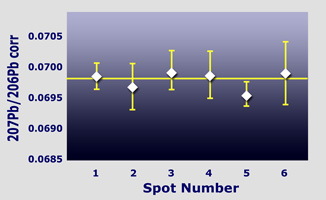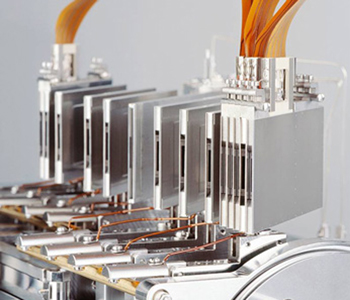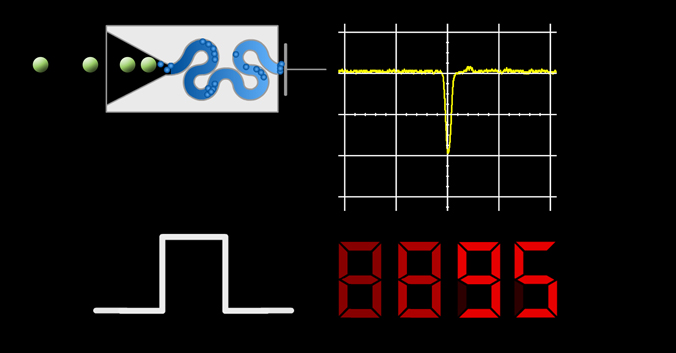Principles of Operation
Channel electron multipliers (CEMs) are detectors, which respond to charged particles, hard and soft X-rays, and ultraviolet radiation.
A CEM has a high surface resistance. When a potential is applied between the input and output end of the CEM, the resistive surface forms a continuous dynode. A dynode has the property of emitting secondary electrons when primary particles impinge upon it (Fig. 2). This process is called secondary electron emission. Through this process, a CEM is capable of detecting a particle or photon that has entered its funnel-shaped input aperture. These primary particles generate secondary electrons that are accelerated down the channel by a positive bias. Upon striking the interior surface of the channel walls, these electrons then generate further secondary electrons. The resulting avalanche process produces an easily detectable output pulse of charge containing up to 10e8 electrons with a duration (FWHM) of about 8 nanoseconds.
If the electron cloud is collected with an anode, a single pulse is produced that appears on the oscilloscope as shown in Fig. 3. For an input of one primary particle a CEM thus produces an electron cloud of about 100 million electrons. The output pulses can be detected easily by using a discriminator, a preamplifier and a counter or as an input current in the analog mode.
| Fig. 4 From primary particle to counter registration |
This enables the detection of over 5 million particles per second with the standard type CEMs and over 15 million particles per second with the extended dynamic range types. Due to the very low dark count rate of < 0.02 cps, which is caused by cosmic rays, the dynamic range for measurements is greater than 8 orders of magnitude. Fig. 1 shows a cut view of a CEM type KBL210. The ceramic forms the structure and the black lead glass a continuous dynode with a secondary electron emitting surface. The electron avalanche that is generated by a primary particle follows the channel to the positively charged end and is collected by an anode. The curvature of the channel is necessary to prevent ion feedback caused by the high electron density at the end of the channel. In a straight channel ions would pick up too much kinetic energy and generate additional secondary electrons leading to an unstable operation of the CEM.
| |
|
|
|
|
| |
User Report |
|
Courtesy of J. Schwieters
|
|
Thermo Fisher Scientific GmbH, Bremen |
| |
|
|
|
|
| |
|
|
|
|
| |
Why Multi-Ion Counting? |
|
|
|
| |
|
|
|
|
| |
Low signal intensities are produced by laser ablation when high spatial resolution is required, when the total sample amount is limited, and/or when U and Pb contents of zircons are low. The signal to noise level of Faraday detectors is too low to obtain high precision data. This is illustrated in Fig. 1-5, which shows simultaneous peak scans of |
|
tivity of the instrument by several orders of magnitude. In addition, because laser ablation sampling can produce erratic transient signals, static multicollection is an absolute must when high precision is required. This points to the need of a flexible multicollector with ion counting detectors instead of Faraday cups.
For example, the isotopes of U and Pb can be measured in individual zircon grains to determine the amount 207Pb and 206Pb that have accumulated in the zirconium silicate matrix from the natural radioactive decays of 235U and 238U, respectively. Data were collected over a 70 s window. Six different locations on a 91500 zircon standard were analyzed and the average 207Pb/206Pb ratio had a standard deviation of ± 0.22 %.

|
|
| |
|
|
| |
 |
| |
|
|
|
| |
Multiple collector array from the ThermoFisher NEPTUNE and TRITON include Sjuts channel electron multipliers type 0210P. |
|
|
| |
|
|
|
| |
the 206Pb and 207Pb isotopes of SRM 981 standard. The intensities of both isotopes are about 1mV, however, compared to the Faraday detector the noise on the ion counting channel is significantly reduced. Ion counters are used to extend the sensi- |
|
The results of laser ablation multi-ion counting inductively coupled plasma mass spectrometric analysis of single zircon grain (Fig. 6). |
|
| |
|
|
|
|
-
|

